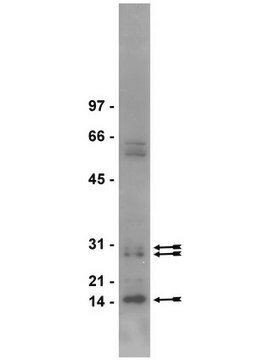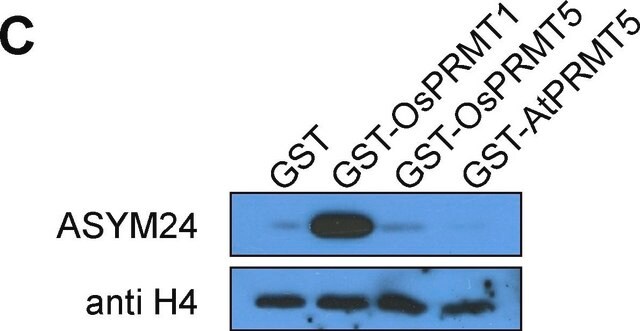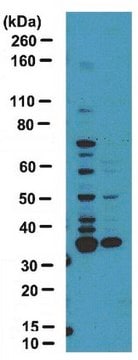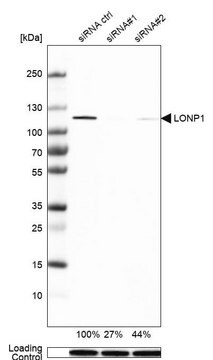07-413
Anti-dimethyl-Arginine Antibody, symmetric (SYM11)
Upstate®, from rabbit
Synonym(s):
Anti-SYM11, Anti-dimethyl-Arginine, Symmetric Dimethyl-Arginine Ab
Sign Into View Organizational & Contract Pricing
All Photos(1)
About This Item
UNSPSC Code:
12352203
eCl@ss:
32160702
NACRES:
NA.41
Recommended Products
biological source
rabbit
Quality Level
antibody form
purified antibody
antibody product type
primary antibodies
clone
polyclonal
species reactivity
human, mouse
manufacturer/tradename
Upstate®
technique(s)
western blot: suitable
isotype
IgG
shipped in
dry ice
target post-translational modification
unmodified
General description
Symmetrical dimethylated arginine (sDMA) is a product of the post-translational modification, arginine methylation. sDMA is a structural isomer of asymmetric dimethylarginine.
Specificity
SmD3 at ~16kDa, and other proteins that contain arginines that are symmetrically dimethylated
Immunogen
peptide corresponding to amino acids 99-119 of Small nuclear ribonucleoprotein SmD3.
Application
Anti-dimethyl-Arginine Antibody, symmetric (SYM11) has been used in:
- co-immunoprecipitation (co-IP)
- western blot analysis
- immunoprecipitation
Biochem/physiol Actions
Symmetrical dimethylarginine (sDMA) is a competitor of arginine transport and is eliminated through renal excretion. sDMA serves as a marker to indicate the estimated glomerular filtration rate (GFR) and the coronary artery disease (CAD) severity. Elevated sDMA is associated with the risk of cardiovascular disease and mortality. It might also help in the early detection of chronic kidney disease. sDMA acts as an endogenous marker of renal function. It is associated with tumorigenesis.
Quality
routinely evaluated by immunoblot in RIPA lysates from Jurkat cells
Target description
~16 kDa
Physical form
Format: Purified
Analysis Note
Control
Positive Antigen Control: Catalog #12-303, Jurkat cell lysate.
Positive Antigen Control: Catalog #12-303, Jurkat cell lysate.
Legal Information
UPSTATE is a registered trademark of Merck KGaA, Darmstadt, Germany
Not finding the right product?
Try our Product Selector Tool.
Storage Class Code
10 - Combustible liquids
WGK
WGK 1
Certificates of Analysis (COA)
Search for Certificates of Analysis (COA) by entering the products Lot/Batch Number. Lot and Batch Numbers can be found on a product’s label following the words ‘Lot’ or ‘Batch’.
Already Own This Product?
Find documentation for the products that you have recently purchased in the Document Library.
Ming Gao et al.
EMBO reports, 16(3), 379-386 (2015-01-21)
Germ cells give rise to all cell lineages in the next-generation and are responsible for the continuity of life. In a variety of organisms, germ cells and stem cells contain large ribonucleoprotein granules. Although these particles were discovered more than
Rui Liu et al.
Microbiology spectrum, 11(6), e0290623-e0290623 (2023-10-26)
PRMT5 contributes to secondary metabolite biosynthesis in Ganoderma lucidum. However, the mechanism through which PRMT5 regulates the biosynthesis of secondary metabolites remains unclear. In the current study, PRMT5 silencing led to a significant decrease in the biosynthesis of polysaccharides from
Zi Wang et al.
Communications biology, 7(1), 241-241 (2024-02-29)
PRMT5, a type II arginine methyltransferase, is involved in transcriptional regulation, RNA processing and other biological processes and signal transduction. Secondary metabolites are vital pharmacological compounds in Ganoderma lucidum, and their content is an important indicator for evaluating the quality
Jérémy Dufourt et al.
Nature communications, 8(1), 1305-1305 (2017-11-05)
Piwi-interacting RNAs (piRNAs) and PIWI proteins play a crucial role in germ cells by repressing transposable elements and regulating gene expression. In Drosophila, maternal piRNAs are loaded into the embryo mostly bound to the PIWI protein Aubergine (Aub). Aub targets
Claudia Dominici et al.
eLife, 12 (2023-06-07)
In skeletal muscle, muscle stem cells (MuSC) are the main cells responsible for regeneration upon injury. In diseased skeletal muscle, it would be therapeutically advantageous to replace defective MuSCs, or rejuvenate them with drugs to enhance their self-renewal and ensure
Our team of scientists has experience in all areas of research including Life Science, Material Science, Chemical Synthesis, Chromatography, Analytical and many others.
Contact Technical Service








